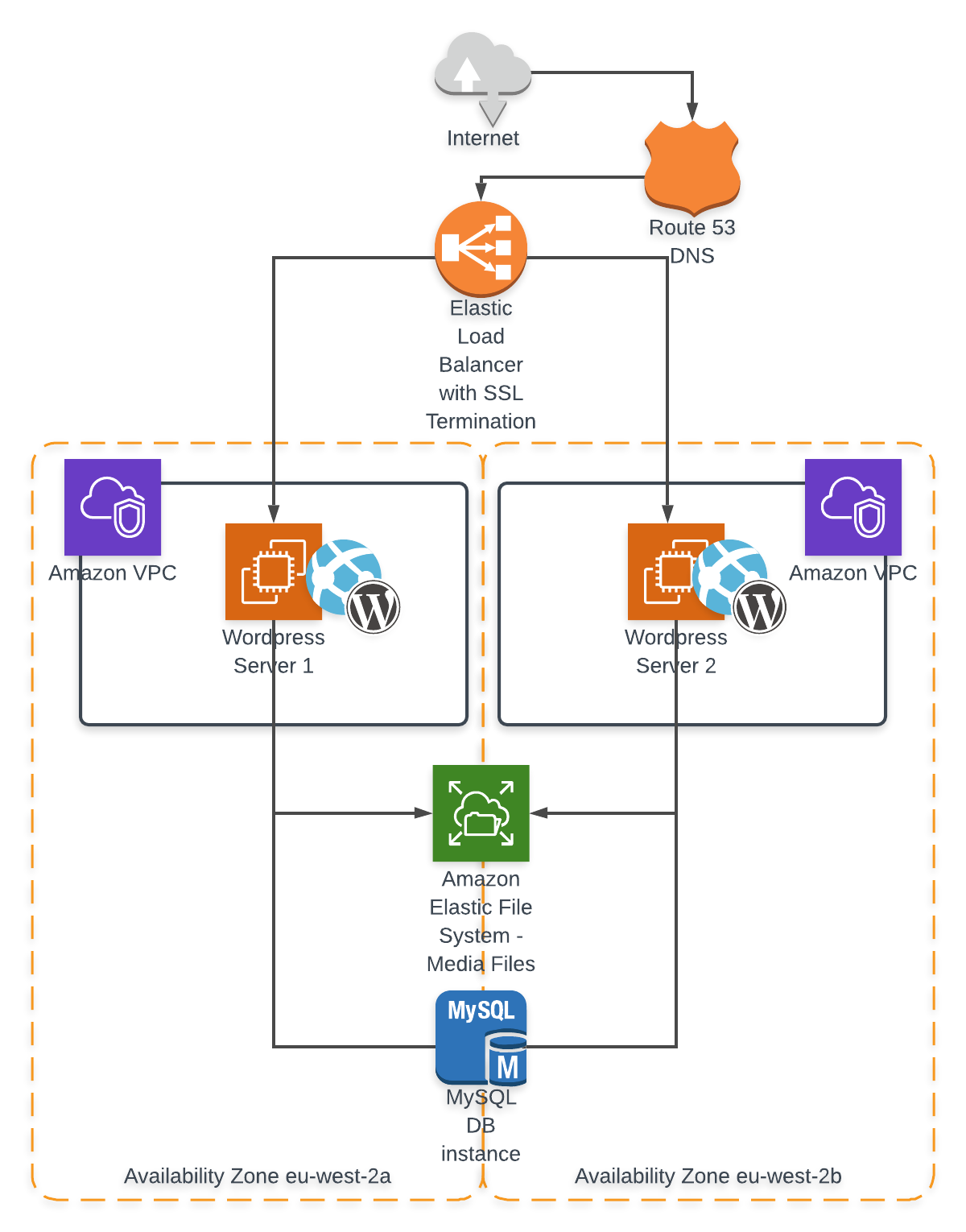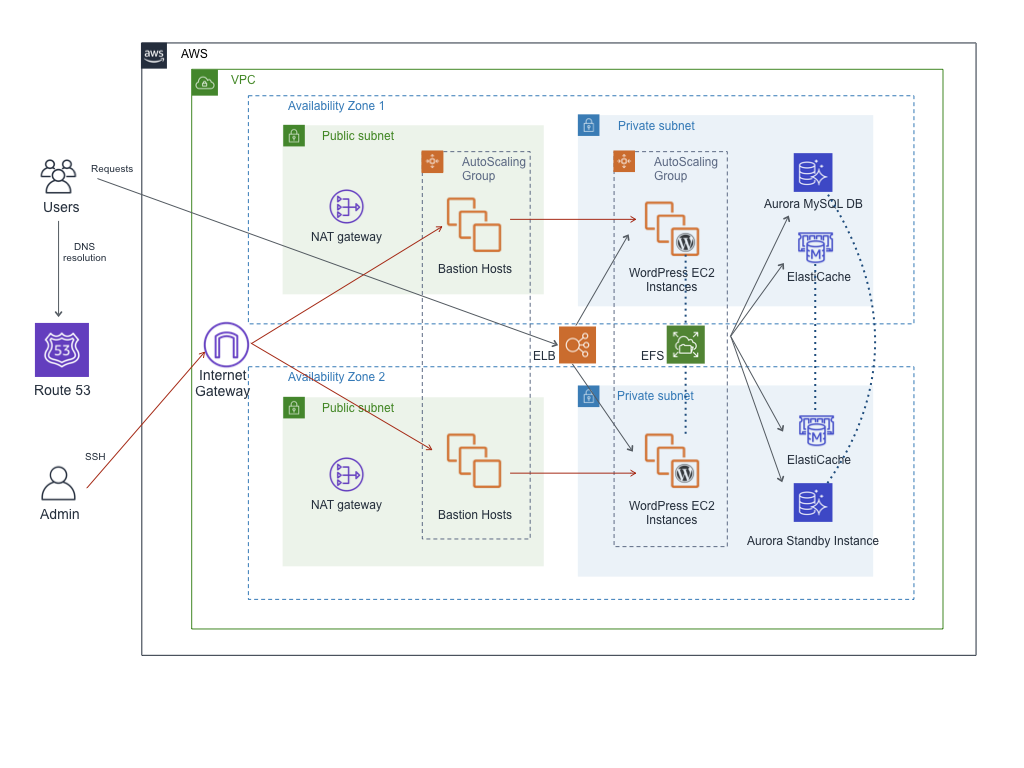
Lightsail provides templates for commonly used applications such as WordPress. This template is a great starting point for running your own WordPress website as it comes pre-installed with most of the software you need. Overview WordPress is a highly popular content management system (CMS) that is used for over 30% of all sites on the internet. It is most commonly used for blogs but can also be used for running e-commerce sites, message boards, and many other popular use cases. What You Will Learn. Taking WordPress Site Live on AWS – Cloudways Nearly half of the active websites on the internet use WordPress to power their websites, and for a good reason. To begin with, it's open-source, which basically means you can use it for free. Launch a web stack to host your WordPress application using AWS Elastic Beanstalk and Amazon Relational Database Service (RDS). Elastic Beanstalk provisions and manages the underlying infrastructure (e.g., Amazon EC2 instances) and stack components (e.g., OS, web server, language/framework) for you. RDS provides the MySQL database. Bitnami WordPress Stack for AWS Cloud. WordPress is the world's most popular blogging and content management platform. Powerful yet simple, everyone from students to global corporations use it to build beautiful, functional websites.
Aws Wordpress Cloudformation
In this project, you will learn how to deploy and host WordPress, an open-source blogging tool and content management system (CMS) based on PHP and MySQL. You will implement an architecture to host WordPress for a production workload with minimal management responsibilities required from you. Virtualbox running slow on mac. To accomplish this, you will use AWS Elastic Beanstalk and Amazon Relational Database Service (RDS). Once you upload the WordPress files, Elastic Beanstalk automatically handles the deployment, from capacity provisioning, load balancing, auto-scaling to application health monitoring. Amazon RDS provides cost-efficient and resizable capacity, while managing time-consuming database administration tasks for you.
See all results for this question.
Launch a web stack to host your WordPress application using AWS Elastic Beanstalk and Amazon Relational Database Service (RDS). Elastic Beanstalk provisions and manages the underlying infrastructure (e.g., Amazon EC2 instances) and stack components (e.g., OS, web server, language/framework) for you. RDS provides the MySQL database.

Deploy WordPress using AWS Elastic Beanstalk. You'll upload the code to Elastic Beanstalk, which handles all deployment details for you.

An AWS Account: You will need an AWS account to begin provisioning resources to host WordPress. Sign up for AWS.
Skill level: Prior experience with WordPress is required.
AWS Experience: Intermediate familiarity with AWS and its services is recommended.
The total cost of building a WordPress website will vary depending on your usage and the instance types you select for the web server and database instance. Using the default configuration recommended in this guide, it will typically cost $450/month to host the WordPress site. This cost reflects the minimum resources recommended for a production ready WordPress workload, with only one active web server and a separate Amazon RDS MySQL database instance. The total cost may increase if you use Auto Scaling to increase the number of web server instances in the event of increased traffic to your WordPress site (approximately $75/month for each additional web server assuming that the web server is active for the entire month). To see a breakdown of the services used and their associated costs, see Services Used and Costs.
Dynamic content elementor. Need more resources to get started with AWS? Visit the Getting Started Resource Center to learn more.
This whitepaper describes a more thorough implementation of WordPress using AWS Elastic Beanstalk. It includes instructions on setting up a CDN and in-memory caching for your WordPress deployment using Amazon CloudFront and Amazon ElastiCache.
Aws Wordpress High Availability

Find and launch pre-configured images running WordPress from the AWS Marketplace.
Aws Wordpress Ssh

Lightsail provides templates for commonly used applications such as WordPress. This template is a great starting point for running your own WordPress website as it comes pre-installed with most of the software you need. Overview WordPress is a highly popular content management system (CMS) that is used for over 30% of all sites on the internet. It is most commonly used for blogs but can also be used for running e-commerce sites, message boards, and many other popular use cases. What You Will Learn. Taking WordPress Site Live on AWS – Cloudways Nearly half of the active websites on the internet use WordPress to power their websites, and for a good reason. To begin with, it's open-source, which basically means you can use it for free. Launch a web stack to host your WordPress application using AWS Elastic Beanstalk and Amazon Relational Database Service (RDS). Elastic Beanstalk provisions and manages the underlying infrastructure (e.g., Amazon EC2 instances) and stack components (e.g., OS, web server, language/framework) for you. RDS provides the MySQL database. Bitnami WordPress Stack for AWS Cloud. WordPress is the world's most popular blogging and content management platform. Powerful yet simple, everyone from students to global corporations use it to build beautiful, functional websites.
Aws Wordpress Cloudformation
In this project, you will learn how to deploy and host WordPress, an open-source blogging tool and content management system (CMS) based on PHP and MySQL. You will implement an architecture to host WordPress for a production workload with minimal management responsibilities required from you. Virtualbox running slow on mac. To accomplish this, you will use AWS Elastic Beanstalk and Amazon Relational Database Service (RDS). Once you upload the WordPress files, Elastic Beanstalk automatically handles the deployment, from capacity provisioning, load balancing, auto-scaling to application health monitoring. Amazon RDS provides cost-efficient and resizable capacity, while managing time-consuming database administration tasks for you.
See all results for this question.
Launch a web stack to host your WordPress application using AWS Elastic Beanstalk and Amazon Relational Database Service (RDS). Elastic Beanstalk provisions and manages the underlying infrastructure (e.g., Amazon EC2 instances) and stack components (e.g., OS, web server, language/framework) for you. RDS provides the MySQL database.
Deploy WordPress using AWS Elastic Beanstalk. You'll upload the code to Elastic Beanstalk, which handles all deployment details for you.
An AWS Account: You will need an AWS account to begin provisioning resources to host WordPress. Sign up for AWS.
Skill level: Prior experience with WordPress is required.
AWS Experience: Intermediate familiarity with AWS and its services is recommended.
The total cost of building a WordPress website will vary depending on your usage and the instance types you select for the web server and database instance. Using the default configuration recommended in this guide, it will typically cost $450/month to host the WordPress site. This cost reflects the minimum resources recommended for a production ready WordPress workload, with only one active web server and a separate Amazon RDS MySQL database instance. The total cost may increase if you use Auto Scaling to increase the number of web server instances in the event of increased traffic to your WordPress site (approximately $75/month for each additional web server assuming that the web server is active for the entire month). To see a breakdown of the services used and their associated costs, see Services Used and Costs.
Dynamic content elementor. Need more resources to get started with AWS? Visit the Getting Started Resource Center to learn more.
This whitepaper describes a more thorough implementation of WordPress using AWS Elastic Beanstalk. It includes instructions on setting up a CDN and in-memory caching for your WordPress deployment using Amazon CloudFront and Amazon ElastiCache.
Aws Wordpress High Availability
Find and launch pre-configured images running WordPress from the AWS Marketplace.
Aws Wordpress Ssh
Accelerate your Wordpress website with Lightsail. It provides everything you need to jumpstart your website on AWS—compute, storage, and networking—for a low, predictable price.

